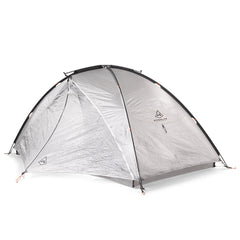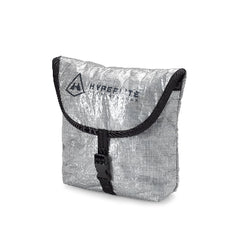Words and Photos from Tina Haver Currin
With longer days, hotter afternoons, and the dreaded arrival of biting insects, late spring is once again sliding into summer—which also means it’s thru hiking season. Northbound (NOBO) hikers are at least a few weeks into their treks, while southbound (SOBO) hikers are likely gearing up to begin their journeys. In fact, I am writing this from mile 403 of the Pacific Crest Trail, where I am attempting a second thru hike myself (I hiked the AT in 2019.)
If you’ve stumbled onto this post via Hyperlite’s channels, you’re probably already familiar with the concept of thru hiking. Maybe you’ve already done a long trail yourself, know someone who has, or you’re planning to tackle one soon. But for those who aren’t a part of the community, it can be pretty perplexing. Some of the most challenging experiences I’ve had aren’t related to steep climbs or lengthy water carries. Sometimes, the hardest part is trying to explain to your loved ones just what the heck you’re doing.
There are certain things that only come into focus after you’ve lived in the woods for an extended period of time and several that are simply counterintuitive. This is a post to share with your friends and family who may not understand (or immediately share) your enthusiasm for big mile days, funky gas station resupplies, and sleeping in the dirt.

IT’S ACTUALLY QUITE SAFE ON TRAIL
Whether patrolling hundreds of miles of trails as a National Park Ranger or walking across the country as a long-distance hiker, I’ve spent many years of my life ambling along our nation’s esteemed nature paths and conversing with the people who inhabit them. I’ve seen bears, rattlesnakes, rockslides, water crossings, and all manner of severe weather. I was evacuated off of the Appalachian Trail in 2019 due to my proximity to a murder.
Even still, I believe that long trails are among the safest places in America. Not only do the statistics back this up, but hikers are an extremely tight-knit group, forming bonds (or “trail families”) as they walk. These “families” become like pearls on a necklace, with familiar faces stretched out for many miles along a single length of trail. Important information about oddball people, difficult conditions, and cold beer makes its way through the trail grapevine faster than the speed of light (or text.) It’s nearly impossible to stay anonymous on a long trail, and helping one another out isn’t the exception; it’s the expectation.
In fact, there are some miraculous souls who devote all of their spare time and energy to helping hikers. They are called “trail angels,” and I could write an entire scroll’s worth of praise for them.

TRADITIONAL COMMUNICATION IS WEIRD OUT HERE
I know folks out there in the real world imagine that a jobless person walking through the woods has loads of free time; however, my hiking days are often much fuller and more exhausting than any days working a full-time job back at home. There’s no couch to fall back on, no stocked fridge for grazing, no real rest break. It’s go-go-go until you’re too tired to go anymore, and when that time inevitably comes, you toss your stuff onto the ground and immediately collapse into sleep, all before waking up to do it over again.
So, don’t be surprised if communication comes in fits and bursts. Not only are hikers contending with spotty cell service in the backcountry, but there’s also an intricate dance between battery power and “town time” that’s hard for those with unlimited power outlets to understand. Most hikers carry a battery bank that’s capable of providing a few additional charges on a cell phone, but most phones also function as a map, guidebook, camera, journal, alarm clock, etc. Town stops--where you can charge both your phone and your battery bank are few and far between, so it’s imperative that hikers conserve this electronic resource to keep them safe and moving through the next stretch.
Plus, they’re so very tired.

THE FASTEST WAY TO A HIKER’S HEART IS WITH FOOD—BUT NOT JUST ANY FOOD
Even non-hikers know that we famously subsist on things like Pop-Tarts and ramen. We joke about the crappy nutritional conditions on trail so often that our loved ones might think that we want these things all the time. We appreciate your thoughtfulness, but I promise you, we do not need any additional Pop-Tarts or M&Ms in the mail. We’re usually eating this junk because it’s the only thing available on rural or remote routes.
Imagine planning for an extreme endurance event based on what you can rummage up in a gas station. Now, imagine what you’d rather have to eat. If you’re cooking for a hiker, fresh fruits and vegetables are always in high demand, in addition to protein and carbohydrate-rich foods. And if you’re sending your hiker a resupply box (great!) or unsolicited goodies (even better!), look for things local to your area that will provide a unique or interesting flavor experience. Chocolate peanut butter? Had it a zillion times. Lemon poppy seed? Hatch chili? Banana walnut? You’re looking at the new mayor of Hiker Town.

IT’S BEST NOT TO BUY A HIKER UNSOLICITED GEAR
If you’re on this website, either you or your loved one are at least mildly interested in gear. Buying supplies for your hiker is a very thoughtful gesture and can make a huge difference in the comfort or outcome of their trip. But purchasing unsolicited gear, especially for an experienced hiker, is a bit like giving a coin collector a random fistful of change and expecting them to get excited about it.
Long-distance hiking is a very specific, very niche hobby. Most people have researched, considered, and then reconsidered everything they’re carrying, often down to the ounce and sometimes down to the gram. Every piece has a very specific purpose—frequently, more than one—and usually fits into a thoroughly vetted, pre-established system. If you’d like to gift your hiker with something that they’ll be truly excited to use, ask them about their preferences and the weak spots in their setup, and then get them the lightest, most durable version of that thing that you can find.

MAKING PLANS BECOMES INCREASINGLY DIFFICULT AS TIME GOES ON
Without fail, the more kindhearted and adventurous among my friends will ask where to send supplies or how to hike a section with me. And, without fail, it always slides from a nice idea into a stress-fest. It’s simply impossible to plan a 2,000-mile journey by foot with any degree of certainty, and the days are so faux-busy (see above) that it’s often complicated to incorporate even the smallest of changes into an established routine.
There are so many unknown factors that influence the rate at which one can hike, like weather conditions, energy levels, surprise injuries, trail families, and water or food scarcity. After a few weeks, planning styles range from “I’ve got the next few days figured out” to “I kinda know what I’m doing for the next 15 minutes.” Nobody, despite their spreadsheets or goals, escapes the long-distance guessing game. If you’re hoping to hook up with or do something nice for a hiker (and we certainly hope that you will), pack your patience. Be prepared for last-minute changes, random strangers tagging along, or missed opportunities—but also be prepared for some of the deepest gratitude around.

WE MIGHT BE A LITTLE WEIRD WHEN WE GET BACK
And I’m not just talking about our bodies, which will almost certainly look frayed and frazzled beyond recognition. I’m talking emotionally and mentally, too. It’s a common phenomenon for thru hikers to experience depression and listlessness after completing a long trail.
Imagine spending all day in the woods with a very specific intention, surrounded by friends, working really, really hard to do just one thing. No bills, no job, no outside obligations. You wake and sleep by the sun, eat whatever the hell you want, and you have a great tan. Your brain is drunk on dopamine and endorphins from all the physical activity you’re doing, and your body feels capable of achieving monumental, almost indescribable things.
But once you get home, you still have insatiable hunger. You’re no longer burning 5,000 calories, but you still want to eat like it. The sudden lack of camaraderie, wilderness, and mission is jarring. For some, the fulfillment of a lifelong dream can result in a lack of purpose and meaning.
Be gentle as your hiker crash-lands back into a frenetic society. And then, when they’re ready, see #3 (food) and #4 (gear) to help them get ready to dream up the next adventure.
Tina Haver Currin is writer, activist, and outdoors enthusiast based in North Carolina. From 2016 - 2018, she lived in a Sprinter with her husband, two cats, and a dog, climbing as many mountains, running as many trails, and seeing as many National Parks as humanely possible. Whether climbing in the Rockies, bushwhacking through Arctic backcountry, hiking deep within the Grand Canyon — or, most recently, thru-hiking the Appalachian and Pacific Crest Trails— she discovered the variety of experiences one can have in our wild spaces and the joy of sharing what she has learned with others. Tina currently spends her time writing, hiking, eating, and working as a ranger in the Blue Ridge Mountains.























